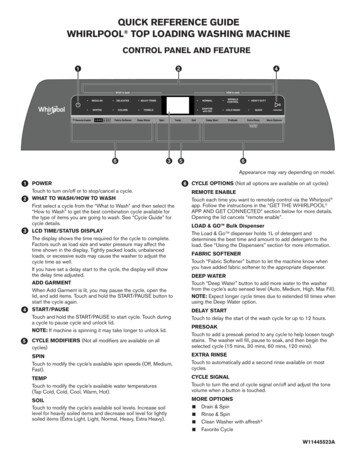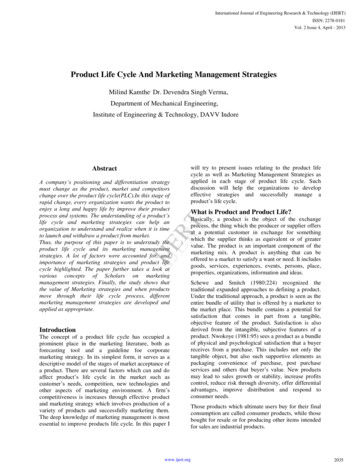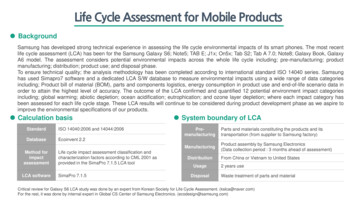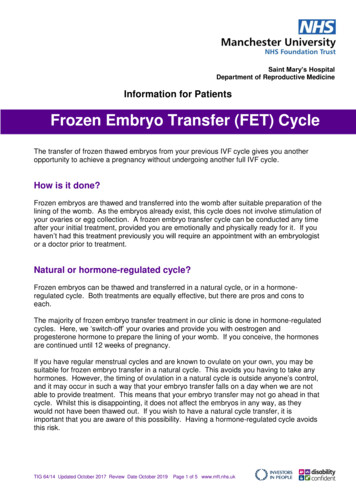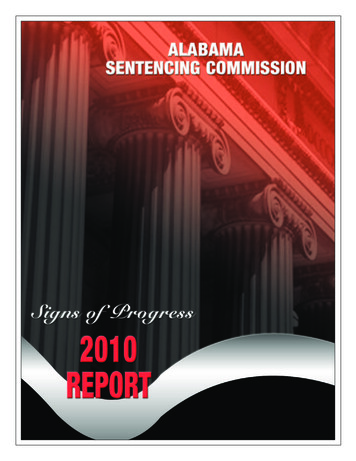
Transcription
Breaking the CycleTHE SECOND PROGRESS REPORTOntario’s Poverty Reduction Strategy2010 Annual Reportontario.ca/breakingthecycle
Minister’s MessageTwo years ago, Ontario released the first Poverty Reduction Strategy in the province’s history. For the firsttime, Ontario formally recognized that child poverty is not acceptable. In order to enshrine our commitment topoverty reduction in law, we introduced legislation that passed with all-party support. As Minister of Childrenand Youth Services, I am privileged to lead our government’s ambitious plan to reduce poverty in Ontario,and fulfill the vision we all share of a province in which everyone – regardless of his or her background orcircumstances – has the opportunity to succeed.Not only is poverty morally unacceptable, as a province we quite simply cannot afford it. We cannot afford toignore the lost potential of children growing up in poverty and its broader impact on us all. We strategicallytargeted our efforts to strike at the roots of poverty because we believe that children should have theopportunity to succeed and contribute. We believe in reducing barriers and working together to build astronger Ontario.As I reflect on the global recession of the last two years, the importance of our Poverty Reduction Strategy ismade only more evident and our commitment more crucial. The global economic downturn has hurt Ontariofamilies. However, over the last two years, we have taken critical steps to help families get back on their feetand made strategic investments in our children and our economy to fuel the recovery and build a prosperousand thriving province for our future. Without these investments, we know that the impact of the recessionwould have been greater.Many of these investments are already making a difference. Children and families are benefiting from neweducation, health care and early development programs. Thousands of Ontarians have taken advantage ofnew opportunities to prepare for and find employment, and many have received vital financial support and taxrelief in the face of the economic downturn felt here in Ontario and around the world. Much of this work is notyet fully reflected in our baseline income indicators, reported for the first time this year because of StatisticsCanada’s two year data lag. However, we know that the combined investments have meant real change forOntario families. For example, a single mom with a young child working full time at minimum wage now livesabove the poverty line. This is progress we are proud of.As we forge ahead, we will continue to invest in our children and build on the province’s foundational initiatives,like Full-Day Kindergarten, child care and the Ontario Child Benefit. We will continue to invest in our publiceducation system and our postsecondary schools because we know that education increases the potentialfor prosperity. And, we will continue to reduce barriers, streamline our social services and develop strong,integrated and supportive communities. Long-term poverty reduction is a shared responsibility that requires allhands on deck. We continue to call on the federal government to play its vital role, and encourage all Ontariansto recognize that each of us has the opportunity to make a difference.I want to congratulate Premier McGuinty, the Honourable Deb Matthews, and my colleagues at the ResultsTable for championing poverty reduction in this province, and I would like to thank the thousands of individualsand organizations who contribute to the fulfillment of this vision every day. In that spirit, I am pleased topresent this report on the first two years of Ontario’s five year Poverty Reduction Strategy, and look forward toachieving continued success over the next three years.The Honourable Laurel BrotenMinister of Children and Youth Services
Ontario’s Poverty Reduction StrategyThe roots of poverty are complex and the task of reducing poverty in Ontario is multi-facetedand challenging. Ontario’s Poverty Reduction Strategy sets out a cohesive, integrated andcomprehensive plan designed to address the needs of Ontario children and build structuresnecessary to break the cycle of poverty.Ontario is focusing first on children and their families, with the goal of reducing the numberof children living in poverty by 25 per cent over five years. Our plan is about believing inthe potential of all Ontarians and putting programs and supports in place so we can grow,succeed and contribute our best. It was developed based on values of inclusiveness and withthe goals of increasing opportunities and reducing barriers.All children should have what they need for the best possible start in life: High-quality early learning and child care Opportunities for educational achievement and success in later life Families that have the resources and tools to support their children’s well-beingAll Ontarians should have the opportunities and tools they need to succeed: Tax relief for OntariansAccess to jobs and a path out of unemploymentFair minimum wages and working conditionsSafe and affordable housingStrong economic and social foundations are critical to a prosperous andhealthy Ontario: A growing economy that provides jobs and builds futures for all Ontarians Strong communities and community-based services A not-for-profit sector that is valued and supportedPoverty affects all of us and poverty reduction requires that all of us play a role.The Ontario government acknowledges with gratitude the many partners – individuals,organizations and communities across the province – who are making a difference everyday and helping us realize the vision of Ontario’s Poverty Reduction Strategy.
Table of Contents1. INTRODUCTION: THE FIRST TWO YEARSPage 1About the Poverty Reduction StrategyMaking a difference for OntariansThe first two yearsSupporting Ontario familiesPartnering for poverty reduction2. PROGRESS: BUILDING ON THE FOUNDATIONPage 5Stronger, healthier kids and familiesOpportunity for allStronger economic and social foundations3. MEASURES: INDICATORS AND OUTCOMESPage 20About the indicatorsThe Child and Youth Opportunity WheelThe indicators4. OUTLOOK: FOR 2011Our commitmentMoving forwardBetter partnershipsConclusionPage 27
1. INTRODUCTIONTHE FIRST TWO YEARSOntario’s Poverty Reduction Strategy – the first inour province’s history — was launched in 2008 withan ambitious goal of reducing the number of childrenliving in poverty by 25 per cent over five years. Thisreport provides an important record of our progressduring the first two years and describes the keysteps being taken to help break the cycle of povertyin Ontario and build opportunities that enable everyOntarian to succeed and contribute.About the Poverty Reduction StrategyIn 2007, we made a commitment to build acomprehensive poverty reduction strategy around theOntario Child Benefit, and to work with our partners todevelop indicators and targets to measure and addresschild poverty. Following extensive public consultations,the first Poverty Reduction Strategy in Ontario’s historywas launched in December 2008. To guide and monitorimplementation of the strategy, an innovative ResultsTable of Cabinet ministers, MPPs and external expertswas established in 2009.Poverty reduction came into law in Ontario in 2009 withsupport from all political parties. Recognizing that povertyreduction is a long-term provincial priority, the PovertyReduction Act, 2009 requires the government to reportannually on key poverty indicators and develop a newstrategy, through consultation, every five years. Our goalis to reduce child poverty by 25 per cent over five years.That’s 103,0001 kids according to Statistics Canada’s LowIncome Measure (LIM50), which indicates that in 2008, thechild poverty rate in Ontario was 15.2 per cent.This Progress Report is the first time that the governmentis able to report on the poverty indicators using 20081VisionOntario’s Poverty Reduction Strategy is guidedby the vision of a province where every personhas the opportunity to achieve his or her fullpotential, and contribute to and participate in aprosperous and healthy Ontario.income data. We know that our initiatives are helping toreduce poverty compared to what it would have beenwithout the strategy. However, given the two year time lagin obtaining Statistics Canada data, it is too early for thedata to show the full impact that our investment is makingin moving children and their families out of poverty.Making a difference for OntariansBreaking the cycle of poverty matters to every Ontarianand affects all of us. The moral imperative is clear: everychild in Ontario should have the opportunity to succeedin life, and people facing challenges should be giventhe tools they need to get ahead. Ontario introduced aPoverty Reduction Strategy in 2008 because reducingpoverty is the right thing to do. It is also the smart thingto do. Breaking the cycle of poverty and developing ahealthy, educated and employable workforce is critical tothe economic future of Ontario.The Poverty Reduction Strategy is a comprehensive plan,designed to address poverty in the short term and breakthe cycle of poverty in the long term. The strategy focusesfirst on children and their families. By helping kids living inpoverty get a good start in life and have the opportunitiesthey need to succeed, especially through education, thecycle of poverty can be broken.Learn moreLearn more about Ontario’s Poverty ReductionStrategy at:ontario.ca/breakingthecycleBased on Statistics Canada’s revised methodology for calculating the Low Income Measure. For further information on the revised LIM, see thecyleBreaking the Cycle Ontario’s Poverty Reduction Strategy1
The first two yearsThe global economic recession and financial crisis hashad a serious impact on Ontario families. While thefiscal impact has presented challenges, it has madethe Poverty Reduction Strategy all the more important.Reducing poverty - providing the tools that familiesand individuals need to succeed and participate fullyin society - and addressing the economy are commongoals for a prosperous and thriving Ontario.The Open Ontario Plan, released in Budget 2010,recognizes that we need all Ontarians working at theirbest to compete in the global economy. This planwill help Ontario reach its full economic potential andlead to sustained economic growth. Supporting thevulnerable and helping them to succeed is not only fairbut is also good for the economy.Poverty reduction is a crucial component of this plan.Over the past two years we invested heavily in Ontario’syoungest, through initiatives like Full-Day Kindergarten,to ensure every child gets a good start in life andhas opportunities to succeed. We increased financialsupport, through tax credits and the Ontario ChildBenefit, to help families get back on their feet duringthese tough economic times. We took deliberate stepsto keep Ontarians working through stimulus investmentsthat kept jobs in Ontario and improved our social andeconomic infrastructure. And for those that did lose jobs“Ontario Campaign 2000 commendsthe Ontario government for takingleadership by developing a PovertyReduction Strategy. The recession’simpact on poverty rates would be greater,were it not for steps taken to date bythe Ontario government: introducingthe Ontario Child Benefit, investing inaffordable housing, saving subsidizedchild care spaces, and bringing inFull-Day Kindergarten.”Jacquie Maund, Campaign 2000during the recession, we introduced retraining programsto help Ontarians gain employment in our changingeconomy.In the short term we must be realistic. The globaleconomic downturn of the past two years presentsserious challenges to moving our key poverty indicatorsforward. In the short term the recession will affectincomes. However, despite these challenges we havemade progress and our long-term goals and prioritiesremain unchanged. This commitment to povertyreduction is particularly important in the context ofthe current economic challenges facing Ontario andCanada.Looking forward, it is important that we continueto invest in Ontarians, and specifically, in Ontario’schildren. This is an investment in Ontario’s future growthand prosperity. Policies and programs that improveeducation, training, and early childhood education laythe foundation for a smarter, better-equipped workforcethat positions Ontario to prosper.We are in the early stages of a long-term plan andknow that much remains to be done. This ProgressReport outlines the important investments we havemade to help families hit hardest by the recession andto stimulate the economic recovery, and highlightsthe many new initiatives and ongoing progress we aremaking on the Poverty Reduction Strategy.2Breaking the Cycle Ontario’s Poverty Reduction Strategyontario.ca/breakingthecyle
Poverty Reduction Milestones2007 Ontario Child Benefit (OCB) is introduced. Up to 250 per child is delivered to families in July Premier McGuinty makes a commitment to introduce poverty reduction targets A Cabinet Committee on Poverty Reduction is established2008 Public consultations are held Increased support to low-income families is provided as OCB payments reach up to 600 per child annually Student Nutrition Program is expanded Ontario’s Poverty Reduction Strategy is launched2009 A Results Table is established to guide and monitor implementation of the strategy The historic Poverty Reduction Act, 2009 is passed The Ontario Budget 2009 announces major investments in poverty reduction:- The OCB phase-in schedule is accelerated by two years to an annual maximum of 1,100 annually per child- More than 500 million is invested in social and affordable housing- Rent bank funding is stabilized Summer job opportunities for youth are more than doubled as the Youth Opportunities Strategyis expanded After-school programs are rolled out across Ontario, with a focus on high-risk neighbourhoods2010 The 2010 Ontario Budget introduces the Open Ontario Plan to strengthen our economy andcreate more jobs for our families The Budget includes:- Investments in employment standards officers, child care stabilization, career retraining programsand increased access to postsecondary education- Tax reform including personal income tax cuts, and special benefits and credits related tothe HST, property tax, and the sales tax on energy The minimum wage increases to 10.25 The HST is brought in, along with significant support for Ontarians, particularly those with low incomes The Full-Day Kindergarten Program is rolled out in nearly 600 schools across the province forapproximately 35,000 students Healthy Smiles Ontario rolls out, providing up to 130,000 children with access to free dental care The Long-Term Affordable Housing Strategy is released A review of social assistance in Ontario is announced with the goal of improving employmentoutcomes, reducing complexity, improving fairness and removing barriersontario.ca/breakingthecyleBreaking the Cycle Ontario’s Poverty Reduction Strategy3
Supporting Ontario familiesIn 2009-2010 we took important steps to move forwardon poverty reduction, while providing help to those mostaffected by the economic downturn.We know that the best way to break the cycle of povertyis to invest in our kids, invest in education, and inprograms that support our kids to stay in school. Thisyear about 35,000 four- and five-year-olds in almost600 schools are attending Full-Day Kindergarten.Research shows that children who participate in Full-DayKindergarten get a solid foundation for future learning.The program will be expanded over time, with a goalof having it available in all publicly funded elementaryschools in five years.We also know that a critical part of poverty reduction is toensure that low-income working parents continue to haveaccess to affordable, high quality child care so theycan go back to work or school. In Budget 2010, 8,500licensed child care spaces throughout Ontario weresaved when the province committed funding to permanentlyoffset a funding gap left by the federal government.The Ontario Child Benefit (OCB), the cornerstone ofthe Poverty Reduction Strategy, represents a historictransformation of benefit payments that helps alllow-income Ontario families. The benefit’s flexibilityis allowing families to move from social assistance toemployment more easily. The phase-in of this monthlyfinancial support was accelerated by two years in July2009, providing up to 1,100 annually per child to lowincome families. It now reaches over one million Ontariochildren making a positive difference in their lives.Ontario’s minimum wage was increased this year forthe seventh time since 2003 to 10.25 per hour, whiletax relief of 12 billion is being provided to Ontariansover three years, to enhance ongoing sales and propertytax relief, cut personal income taxes, help individualsadjust to the Harmonized Sales Tax (HST), help northernresidents with their energy costs, and proposed helpto parents with the costs of enrolling their children inactivities to be healthy and active. The combined benefitsof many of these initiatives - tax credits, OCB increasesand minimum wage increases - are making it easier forlow-income working families to make ends meet. A singlemother with a small child, working full time would have anannual income of 28,600 in 2010. This is now above the4Breaking the Cycle Ontario’s Poverty Reduction Strategypoverty line and represents an increase of 10,500 from thehousehold’s 2003 annual income of 18,100.This year we also introduced Healthy Smiles Ontario, aprevention-based dental program which is helping lowincome working parents get the care their kids need. Inaddition, we announced a review of social assistance andreleased a Long-Term Affordable Housing Strategy thatwill transform housing delivery in this province.Partnering for poverty reductionReducing poverty in Ontario continues to require the effortsof many. We acknowledge in particular the dedication ofthe many poverty experts, organizations, communities andindividuals living in poverty across the province who remaincommitted to this valuable initiative and who are makinga difference every day in every corner of the province. Wecould not have moved forward without your continued support.A sustained effort to reduce poverty also requires thecommitment of all levels of government. We continue to lookto the federal government, which has a critical and necessaryrole to play in lifting Ontarians out of poverty. While somepositive steps have been taken – the Canada Learning Bondprovides eligible low-income families with up to a 2,000government contribution to their child’s Registered EducationSavings Plan (RESP) – there is much more to do. The SenateSubcommittee on Cities’ report In From the Margins: A Callto Action on Poverty, Housing and Homelessness highlightsthe need for Canada, the provinces and territories to worktogether and make lifting people out of poverty a commongoal. By working in partnership, more progress will be made.“The evidence is very clear that in orderto reduce poverty in the long-termwe must make early investments thatsupport families and ensure healthy childdevelopment. The introduction of Full-DayKindergarten, the stabilization of childcare funding and the continuing effortsto strengthen early learning programsin Ontario signal that this governmentunderstands the tremendous return oninvestment that is possible when weinvest in the early years.”Paul Johnson, Chair,Hamilton Best Start Networkontario.ca/breakingthecyle
2. PROGRESSBUILDING ON THE FOUNDATIONIn 2010, we continued to build on the foundationalwork that began in 2009. Children and familiesHigh-quality early learningand child careremain the key focus of our work in recognitionFull-Day Kindergarten Programthat, through this approach, we can break theIn September 2010, some 35,000 four- and five-year-oldsin nearly 600 schools began participating in Ontario’s firstFull-Day Kindergarten Program, delivered by teams ofteachers and early childhood educators. At many schools,a before- and after-school extended day option, led byan early childhood educator, is also available to families.This innovative program will expand to approximately 800schools in 2011, offering programming for an estimated15,000 additional children. By fall 2012, almost half of allfour- and five- year-olds in Ontario will be enrolled in theprogram and by full implementation in 2015, it will benefitan estimated 247,000 children.intergenerational cycle of poverty. In light ofOntario’s economic climate, we have also takenquick, strategic action to meet the immediateneeds of Ontarians hit hardest by the recession,and invested in building the economic and socialinfrastructure that is critical to achieving ourpoverty reduction goals.Stronger, Healthier Kidsand FamiliesAll children should have what theyneed for the best possible start in life: High-quality early learning andchild care Opportunities for educationalachievement and success inlater life Families that have the resourcesand tools to support their �In these tough times, it’s encouragingto see the government is sticking toa strategy that will be as good forfamilies and children as it is for Ontario’seconomic recovery. Early learning isone of the best stimulus investmentsa government can make to stem aneconomic downturn.”Annie Kidder, People for EducationMany studies have shown that full-day learning programsfor four- and five-year-olds have a positive impact onacademic, social and emotional development, betterpreparing them for Grade One. This gives children a betterchance of finishing high school, going on to postsecondaryeducation and getting a good job. These programs also givethe children’s parents more opportunities to work towards abetter future for their families.According to the experts, this is one of the most importantinvestments we can make to break the cycle of poverty.In their report, Ontario in the Creative Age, Roger Martinand Richard Florida recommend the following, “Makeearly childhood development a high priority. This is theBreaking the Cycle Ontario’s Poverty Reduction Strategy5
highest payoff investment we can make in our long-runprosperity.” The government will invest 200 millionthis year and 300 million in 2011 to support theFull-Day Kindergarten Program. Investments will rise toapproximately 1.5 billion by 2015, when the program isfully implemented in all of Ontario’s elementary schools.Quality child careHigh-quality child care is critically important to the wellbeing of low-income families. In 2010, Ontario committedto permanently filling the funding gap left by the federalgovernment with an investment of 63.5 million per year.This will maintain approximately 8,500 licensed childcare spaces and 1,000 child care jobs, and will helpensure that low-income working parents continue to haveaccess to affordable, high-quality child care, allowingthem to play an active role in the labour force. This year’sinvestment builds on progress previously made in thechild care sector. Since 2003, Ontario has made childcare more affordable by providing an additional 20,000regular fee subsidies. In that time, licensed child carecapacity has grown by over 67,000 spaces. Ontario isalso supporting the child care sector through funding tostabilize local licensed child care as four- and five- yearolds enter the Full-Day Kindergarten Program.In addition, the extended-day component of the Full-DayKindergarten Program offers a cost-effective, seamlesschild care option for working parents.Programming for the early yearsWe know that giving children rich developmental andeducational experiences early in life is critical to buildingtheir future success. Ontario’s early years initiativesprovide children with high-quality early developmentprogramming, and engage parents as partners in theirchildren’s early development and ongoing education. The government has begun developing a policyframework and implementation plans for the creationof Best Start Child and Family Centres that willprovide a seamless and integrated system of supportsand services for Ontario’s children and families. Thisimportant initiative will help ensure that families inevery community across Ontario have timely access toa range of community-based supports for their children,to give them the best possible start in life. Parenting and Family Literacy Centres located in highneeds communities continue to provide parents/caregivers and their children, from birth to six yearsof age, the opportunity to participate in play-basedlearning activities that help kids get a head start ondevelopment and learning. There are currently 145centres operating in the province and in the 2009-10school year these centres had 450,000 visits.Making a DifferenceUrban and Priority High SchoolsThe Alternative Education Program (AEP) at W.F.Herman Secondary School in Windsor is providingnew opportunities to students who are strugglingin the regular academic stream. As one studentcommented, “(The program) has helped me stayin school and not skip my classes made me wantto stay and do my work and get my credit. Themotivation the teachers gave me helped a lot andmotivated me to behave and not act up. Thanks tothem, I’m going to get my two credits.”6Breaking the Cycle Ontario’s Poverty Reduction Strategyontario.ca/breakingthecyle
Opportunities for educationalachievement and success inlater lifeThe best possible poverty reduction strategy is agood publicly funded education system. In additionto the specific initiatives described below, the Ontariogovernment has, over the past seven years, beencommitted to making the province’s publicly fundededucation system one of the best in the world. We areincreasing student achievement and well-being, closingthe achievement gap for struggling students and drivinghigher levels of confidence in publicly funded education.Working together, we are getting results: test scores areup, class sizes are down, the graduation rate continuesto rise and we have labour stability in Ontario’s schools. Learning opportunities – Poverty influences schoolrelated outcomes and some students are at greaterrisk of academic difficulty because of their socialand economic situations. The Learning OpportunitiesGrant (LOG) supports school boards to offer a rangeontario.ca/breakingthecyleof programs to help students reach their academicgoals. These include remedial reading, breakfastprograms, tutors, mentoring, literacy and numeracyskills programs. In 2010, a portion of this grant wasrestructured so that funding is now better alignedwith the number of students who, for socio-economicreasons, are at a higher risk of academic difficulty. Access to school activities – Activity fees are abarrier to participation in school activities for childrenin low-income households. Students should have theopportunity to fully participate in our educationsystem, regardless of their parents’ financial situation.A draft guideline regarding fees for learning materialsand activities was released by the Ministry ofEducation in 2010, with the aim of informingschool board policies on how best to supportstudent participation in school activities. This willsupport the participation of all students in enrichingschool activities and programs that are outside thecurriculum, but enhance a student’s schoolexperience. The final guideline will be released inearly 2011.Breaking the Cycle Ontario’s Poverty Reduction Strategy7
Making a DifferenceParents Reaching Out (PRO) GrantsThrough PRO grant support, Leslieville JuniorPublic School in Toronto offers a spring eventfor parents and children to make the futurekindergarten experience in September easier,particularly for newcomers to Canada. As oneparent wrote to the kindergarten teacher, “Thankyou. I’m not at all worried about the move tokindergarten now. My son runs out of the doorof our house and races to school wheneverhe hears it’s time to come. It has been just ashelpful for parents as the kids. As my son’s futurekindergarten teacher, you learned his nameimmediately and used it often. He respondswell to that.” Parent engagement – Schools should foster andsustain a positive, welcoming school climate in whichall parent perspectives are encouraged, valued andheard.Parent Involvement Committees (PICs) participateat the school board level to support, encourage andenhance the engagement of parents in improvingstudent achievement and well-being. PICs do thisby undertaking activities to help parents support theirchildren’s learning at home and at school, givingadvice to the boards on parent engagement, andcommunicating with and supporting school councils.Parents Reaching Out (PRO) Grants continueto fund innovative local, regional and provincialinitiatives designed to break down the barriers toparent engagement faced by many parents inOntario. For example, PRO grants have been usedto develop programs that provide multi-languageservices, help parents work with their children athome and build connections across diverse culturesin the school. A portion of funding for this programwas refocused to priority schools in high-needs areasfor the 2009–10 school year. In the 2010–11 schoolyear, there was a 25 per cent increase in approvedapplications from priority schools, compared to2009–10.8Breaking the Cycle Ontario’s Poverty Reduction Strategy Specialist High Skills Major Program – Ontario ishelping more high school students get an academicand career edge by expanding its Specialist HighSkills Major Program. This fall, a not-for-profit sectorprogram was launched, offering students anopportunity to obtain hands-on experience atcommunity agencies. In 2010-11, there will be morethan 28,000 students enrolled in over 1,000 SpecialistHigh Skills Major programs in more
Poverty Reduction Strategy in 2008 because reducing poverty is the right thing to do. It is also the smart thing to do. Breaking the cycle of poverty and developing a healthy, educated and employable workforce is critical to the economic future of Ontario. The Pov




